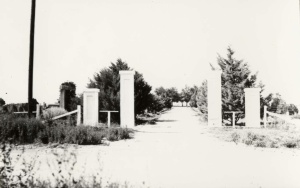There’s Slaton. There’s Englewood Cemetery.
… And then there’s Potter’s Field.
The history of death in Slaton begins one year after the birth of the town – 1912.
On a spring day, May 10, 1912, a small family gathered to bury their infant son, J.W. Obrian. Or, in some documents, the name is spelled J.W. Ohrien. A spelling mistake that has confused many for nearly a century because, after all these years, the child who may or may not have been the first born of a family who left many years ago, was the first to be buried in Slaton.
Although the history and legend of this family remains mysterious, it is easy to imagine the anguish, grief and pain the family felt the day they buried an infant son on the lush green plains with striking purple and yellow wild flowers surrounding the small lonely grave as the soft spring breeze forced the prairie grass to flutter.
According to Slaton’s Story, the first funeral establishment was opened by A.E. Howerton. The first funeral home, which may have helped prepare the young body, began in Slaton earlier that same year of 1912. It is believed to have been located in a small building one street over from Texas Avenue where the VFW building’s parking lot is now situated. It is unknown as to where deceased pioneers were buried prior to the opening of the cemetery and the opening of the first funeral home. It is believed many were buried on private lands.
The second structure to house the local funeral home was opened in 1922 at 235 South 9th Street. The building, which still stands, was constructed by Dr. and Mrs. E.C. Foster who operated a furniture store alongside the funeral home. Many important and prominent citizens were respectfully remembered in this building including the funerals of the some of the original families such as the Brewers’ and Pembers’ and Dr. Sam Houston Adams.
On December 23, 1936, after second and third additions were made to the building, Mr. Webber Beauregard Williams moved his family into the upstairs living area of the building.
Mr. Williams became the third owner of Slaton funeral homes.
“Moving from a residence in the new addition of Spur and into a funeral home on the highway through town was quite a transition,” Glynna Englund, daughter of Williams wrote in Slaton’s Story. “We adjusted,” she wrote. Glynna Englund lived in the upstairs residence of the old funeral home until her recent death.
On May 2, 1944, the funeral home was left, in tragic irony, without a director. Mr. Williams died at the age of 47 after his second heart attack. At the time, and still today, Texas’ laws required anyone operating a funeral home must be a licensed funeral director.
“Through efforts of area funeral director friends,” Glynna wrote, “Mrs. Williams took her state board examination at an unscheduled time and, was licensed within a few months after Mr. Williams’ death.”
In 1944, it is stated in Slaton’s Story that Glynna graduated from Slaton High School. She was studying journalism at Texas Tech University when she met her future husband, Bud Englund. After marriage, the two moved to Dallas where Bud entered the Dallas Institute of Mortuary School. Glynna received her funeral director’s license in 1948.
Glynna’s sons, Dubbing and Robert and grandson Brett, currently operate the funeral home at its present location west of Englewood Cemetery.
The entrance of Englewood Cemetery is that of dignity and respect for the many that came and left before. Rows of large to meager tombstones with names and decorative motifs with final inscriptions that give clue to the loved ones buried beneath Texas soil spread across yards of sacred ground.
According to state records, the cemetery was established by the Santa Fe Railway. It is believed that the infant son of Slaton’s first burial in the 1912 lone Englewood Cemetery was a member of a railroad family.
However that is up for speculation, just like the name of the cemetery – Englewood.
To this day, there are a few theories but no accurate reasoning as to the naming of the cemetery.
“We lived south of Posey until 1918,” W.J. Klattenhoff wrote in Slaton’s Story. “We were there when the older Mr. Posey and his son died in a silo accident along with two Mexicans who tried to rescue them.”
If Mr. Posey and his son were buried in Slaton, their bodies would be interred in the peaceful gardens of Englewood.
However, the two unknown Mexicans who gave their lives in trying to save the pair would have been laid to rest in Potter’s Field; an emerging and stripped piece of land that lies beyond a tree-lined path that has estranged the departed for almost a century.
There were acting Jim Crow Laws in Texas state parks beginning in the late 1800s. However, in 1923, Lubbock County passed an initiative to include the segregation of cemeteries. Slaton officials followed county initiatives.
Potter’s Field is a once detached piece of land that tells a separate story as mysterious as the name Englewood itself.
The land is filled with homemade tombstones of concrete, wood and, in some cases, chipped seashells. The majority of graves remain unmarked and, with just the faint sunken outlines of agedly dug graves, barren fields encompass the area where unknown human remains lie beneath.
The reasoning as to why Potter’s Field exists is because the town needed to bury the unfortunate and poverty stricken few as well as minorities. The cemetery was segregated for many years and because of family lineage, it may seem the same way today.
There’s Slaton. There’s Englewood Cemetery.
And then there is…
… Potter’s Field.

